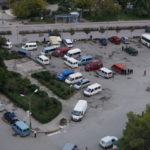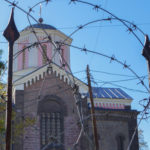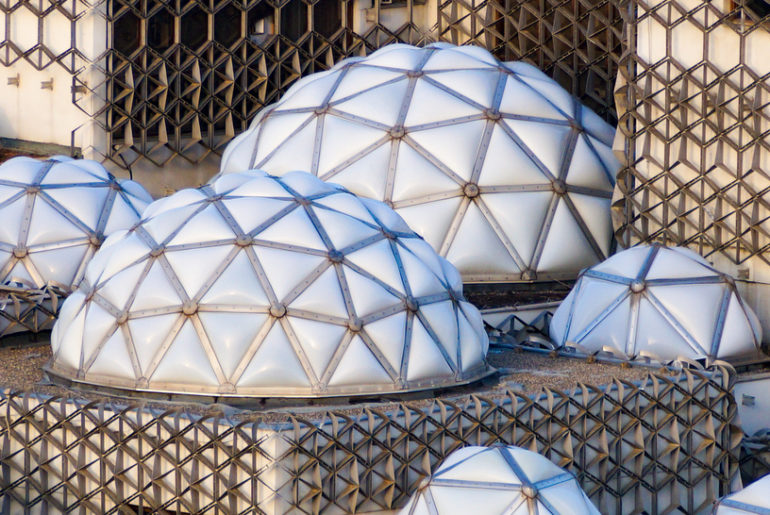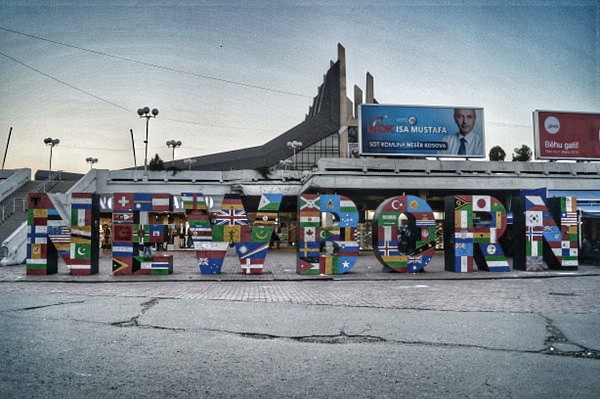“Clear all arms” instructs a sign near the traffic barrier across the road. An Italian guard gets up from his chair positioned in the shade outside the small dark green control building. “Passport,” he demands.
I hand it over and the guard stands inside the control building and makes a call on his mobile. I don’t know if he’s checking up on me but he returns, without my passport, and hands me a small but official looking laminated card declaring me as visitor number three.
The guard reminds me I can’t take photos as I wrap my scarf over my bare shoulders and walk down the road to The Patriachate of Peć.
The deep red monastery is barely visible until I’m in front of it. High stone walls hide it from the road. The monastery is valuable. My information pamphlet reveals the treasury is “among the richest and most valuable church treasuries to be found”. But that’s not the reason for the Italian guard out front and the tight security controls.

National Tourism Organisation of Serbia photo archive.
The Patriachate of Peć is one of the most significant buildings in Serbian history and it sits well inside the boundary identifying Kosovo. The history between Serbia and Kosovo is complicated and I don’t have the knowledge or time to go into it, but the present situation is that Serbia does not recognise the Republic of Kosovo as an independent country. The people of Kosovo (mostly ethnic-Albanians) feel differently.
The location of this Serbian Orthodox monastery in Kosovo territory makes it a potential target and it remains under the administration of the UN. The Serbian tourism information website says visiting the site is only possible under the military escort of the NATO-led KFOR troops.
It’s a complicated situation engulfing such a peaceful and serene site.
As I approach the monastery, walking through a small herd of cows on the way, I see another control point. This guard ignores me and I step through the large iron gates bearing a cross on each. I walk into a garden area. I see two Nuns, dressed in long black robes, talking on the other side. Neither of them acknowledge me. The Patriarchate of Peć sits in the back right corner. Aside from the nuns I am the only person here. I walk slowly around to the stunning red building. Inside are three churches and there is a smaller one attached at the front.
One of the Nuns walks by me without a word and unlocks the door and disappears inside. I’m unsure whether I can follow and stand in the shade of a Mulberry tree that has many of its branches propped up by posts. It’s thought to have been planted 700 years ago.
The exterior of The Patriarchate of Peć is a deep red with striking colours in the details. Bold blues and greens. The windows consist of lots of small glass circles and look like they’ve been made with the bottom of wine bottles. While I’m waiting for an invitation or the nerve to walk in without one, a group of Priests come into the garden and enter the churches. I follow.
After visiting countless churches, temples and monasteries in my travels over the years, I am not easily impressed. But the interior of the Patriarchate of Peć is exquisite. The church looks its age, but still shows signs of life, unlike many ancient churches and monasteries I’ve seen in the Balkans. Many of the frescos are faded or are gone completely, revealing the bare stone underneath. The old desktop computer in the back corner looks very out of place.
The Patriarchate of Peć is the spiritual seat and mausoleum of the Serbian archbishops and patriarchs, which explains its significance and the protection it receives from the UN. It is listed on UNESCO’s List of World Heritage in Danger (as an extension of Visoki Dečani, another Serbian Orthodox Church near Peć, which is similarly controlled) because of the potential for it to be the target of attacks by ethnic-Albanians.
The oldest of the four churches inside is the Church of Holy Apostles, which was built in the 13th century. Two new churches, The Church of St Demetrius and the Church of the Mother Of God, were built in the 14th century. The smaller Church of St Nicholas adjoins the larger building and was constructed in 1330.
An old woman in heavy knit cardigans, a white beret and silver hair down to her hips comes out of one of the buildings and joins the Priests. When I step inside she comes over to tell me about the building while I read the English description that has frequently substituted “c” for “k” throughout. “The arkitekture…” and so on. She doesn’t know where Australia is (I assume she misunderstands me) because she does recognise New Zealand.
The old woman is reeling off dates and information about the stunning frescos while also asking me if I am Catholic or Christian. I tell her that I was baptised Anglican, which isn’t a lie. I leave out the part about now see-sawing between being Agnostic and Atheist. She tells me about an English couple who visited and said they were Anglican, but she had her doubts. I hope she can see the St Christopher charm on my necklace. I fear she’d put that smooth, thin stick she uses for walking and pointing out details in the church to good use if she discovered I was lying.
Back in the garden the Priests are sitting down to tea. I walk back to the gate, nodding to the woman watching over her herd of cows, and collect my passport.
If you go:
The Patriarchate of Peć is about 2km from the centre of Peć just along from the visitor centre for Rugovska Klisura gorge. On the day I visited the monastery was open from 12-5pm. It is free to enter. You will be expected to dress appropriately. Men will need long sleeves and trousers. Women will need their shoulders and knees covered. You will have to surrender your passport at the control point while you visit the monastery.
No photography is allowed near the control point or near the monastery.
*As this is a Serbian site I have used the Serbian name for the city Peć. The city is known as Pejё in Kosovo and Albania.






4 Comments
The red colour is the Serbian Royal colour. Hence the Monastery is painted in red.
Oh thanks Tara, I didn’t know that. I thought it was beautiful (red is my favourite colour).
“As this is a Serbian site I have used the Serbian name for the city Peć”. All toponyms in Kosovo are of Serbian origins. Albanian version is just translation from original name.
Even Kosovo is not of Albanian origin but Serbian and it means Land of Black bird (serb. kos – eng. Black bird)
Interesting to read this again after I visited. My visit was 3 years after you wrote this post, and it seems a few little details have changed. The guard by the road did check my passport, but he gave it back to me before letting me continue down the path to the monastery. Entrance is now 2 euros, and it includes an audio guide, though the person on the audio guide had such a thick accent it took quite a lot of concentration to understand and I probably would’ve been fine without it. The whole time I was there, a couple of guys were there to point out where the next number was since they weren’t always immediately obvious. I didn’t see written descriptions anywhere – maybe they removed them when they added the audio guide? Also, I was allowed to take photos of the outside but not inside. I was the only guest there until I was leaving and returning my headset when a couple showed up. Definitely an interesting place, and I’m glad I went. Thanks again for your help on Twitter before my trip!